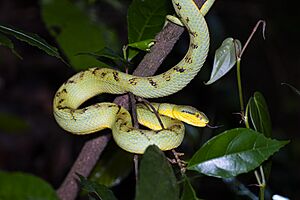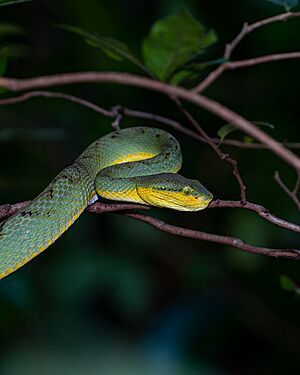Craspedocephalus gramineus facts for kids
Quick facts for kids Craspedocephalus gramineus |
|
|---|---|
 |
|
| Conservation status | |
| Scientific classification | |
 |
|
| Synonyms | |
|
The Bamboo Pit Viper, also known as the Indian green pit viper, is a type of venomous snake. Its scientific name is Craspedocephalus gramineus. You can find this snake in southern and northeastern parts of India. It is a kind of pit viper, known for its heat-sensing pits.
Contents
Discovering the Bamboo Pit Viper
The Bamboo Pit Viper was first described in 1802. It was initially named Coluber graminaeus. Today, scientists do not recognize any different types, or subspecies, of this snake.
What are its common names?
People call this snake by many names. Some common names include:
- bamboo pit viper
- Indian tree viper
- bamboo snake
- Indian green tree viper
- green tree viper
- bamboo viper
- green pit viper
What Does the Bamboo Pit Viper Look Like?
This snake usually has a bright green color. Sometimes, it can be yellowish, greyish, or even purplish-brown. It might have spots of black, brown, or red. Often, there is a light stripe along its side. This stripe can be white, yellow, or red. The tip of its tail is often yellow or red. Its belly is usually green, yellow, or whitish.
How big does it get?
The Bamboo Pit Viper can grow to be about 3.25 feet (1 meter) long. Its tail is usually around 5.5 inches (14 centimeters) long.
Where Does the Bamboo Pit Viper Live?
The Bamboo Pit Viper is found across much of India. It is common in the southern parts of the country. You can also find it, though less often, in eastern India. This includes areas like Odisha, Jharkhand, and West Bengal. The first place this snake was officially recorded was in Visakhapatnam, India.
What is its Habitat Like?
Even though it's called the "bamboo" pit viper, this snake doesn't only live in bamboo patches. It is an arboreal snake, meaning it lives in trees. You will often find it on low to medium-sized bushes and trees. It likes to be near streams.
When is it active?
The Bamboo Pit Viper is a nocturnal animal. This means it is active at night. At night, it comes down to lower branches to hunt. During the day, these snakes climb higher into the trees to rest.
How Does the Bamboo Pit Viper Behave?
Since it lives in trees and is active at night, the Bamboo Pit Viper is an arboreal and nocturnal snake. If it feels threatened, it can be aggressive. It will not hesitate to bite if it feels it needs to defend itself. Its venom is powerful and affects blood and nerves.
What Does the Bamboo Pit Viper Eat?
This snake is a predator. It hunts and eats small animals. Its diet includes lizards, rats, and birds.
How Does the Bamboo Pit Viper Reproduce?
The Bamboo Pit Viper is ovoviviparous. This means the mother snake carries the eggs inside her body. The eggs hatch inside her, and then she gives birth to live young. Female snakes usually give birth to 6 to 11 baby snakes at a time. The young snakes are about 4.5 inches (11.4 centimeters) long when they are born.






